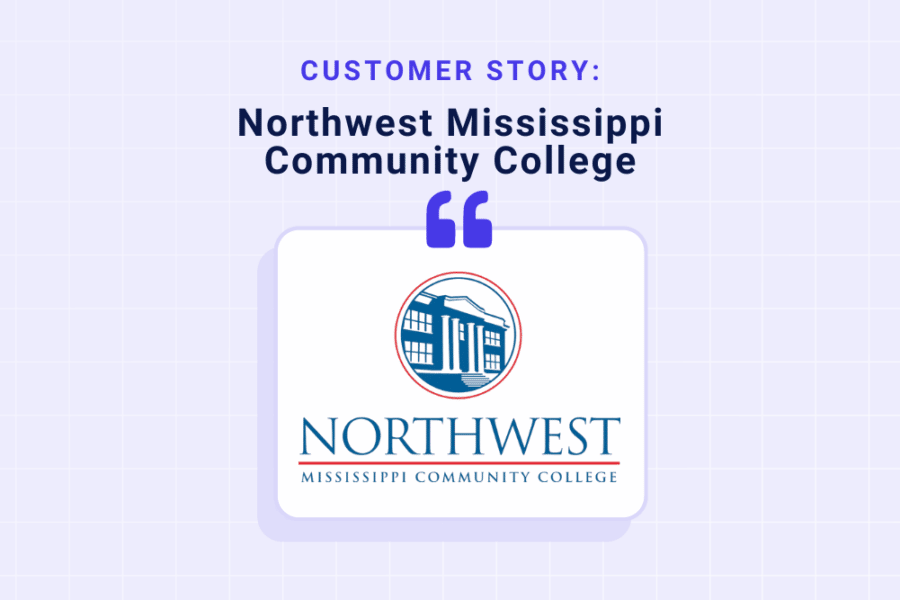
Jamie Turak is an Education Content Manager at Class. He's passionate about storytelling and helping to make education more accessible.

Jamie Turak is an Education Content Manager at Class. He's passionate about storytelling and helping to make education more accessible.

Two-year colleges across the country use online synchronous learning platforms to offer flexibility for instructors and students.
In this Class Story, read how an instructor from Mississippi was instrumental in bringing about synchronous change–so she could move out of state but stay with her students.
Sometimes life brings changes. Yet transitions don’t need to uproot everything, especially your teaching job. In today’s technologically-equipped world, moving out of state as an instructor doesn’t have to mean moving away from your students.
When Shay Carter, an instructor from Northwest Mississippi Community College, moved to Louisiana, she wanted to stay close to her learner community. She wanted a new house in a new town, but not a new college. For educators, home isn’t just where you live but where your heart wants to teach.
For Shay, imagining an ideal scenario created ideal possibilities. She wanted to keep instructing her students in Mississippi while her family settled elsewhere. She didn’t want her life to interrupt her students’ education. She didn’t want a move to mean a professional start-over. She imagined that this move could go differently. She took the initiative to find a synchronous learning solution that worked.
Shay chose Class for remote learning and instruction. She worked with administrators and faculty to implement an online synchronous lecture program for her biology and chemistry classes. Her students learned to use the new-but-familiar virtual classroom software that integrated seamlessly with their asynchronous learning management system, Canvas. She coordinated remote classes around in-person labs between multiple campuses. And restructured lectures to ensure time with students online was engaging and productive.
At Northwest Mississippi Community College–even though she’s now in Louisiana–Shay and her students begin a new journey together. One that uses technology to secure a future-flexible model for education. A world where education is not limited to time and place but works to bridge its divides. Where life changes aren’t regressive–but accommodated and easy to make.
Putting her science classes online added value for Shay and her students. Now, students who take her class have flexible locale options. They can choose between multiple campuses or stay at home for class. In addition, her college gets to keep her on staff, ensuring high student success rates. And Shay makes her impact from another state away, which doesn’t mean another world.
Below, hear from Shay Carter directly. Learn how Class supports a flexible learning system for her college’s science program. Read how the transition is going and what she’s learned, and appreciate Shay’s active role in reimagining her career instruction.
With my husband’s job, we moved 500 miles away from our college to southern Louisiana. So I was forced to re-evaluate. This meant teaching entirely asynchronously, finding a new job, or figuring out the synchronous piece. I chose synchronous because I wanted to stay close and connected with my students, from their on-screen interactions to their faces and live learning comprehension.
I believe synchronous–or HyFlex–has been very beneficial for my students because it’s provided closer looks at information. They can see my face better while we’re in a lecture. They can see models on screen – I can hold up chemical models and things like that. It feels more intimate than an asynchronous system, and I can record and play back lectures.
They like flexibility. We have three campuses; a large main campus, a mid-sized campus, and a third small campus. Now, my students can take my class on any campus. Or they can take it home and drive to the lab. They have options to make it work.
This is only my sixth year teaching. So I’m not a veteran twenty-year person. But even during that time, I’ve done a lot to make myself valuable as an instructor: regarding the quality of instruction, course design, and active learning. So that was the benefit I noted when I approached them to talk about remote instruction.
I said, look, you’ve seen my track record. You know the quality of my instruction. You see how well my students perform. You know my withdrawal rate. So let’s talk about how to keep me involved in teaching these students because it’s working. At some level, being an advocate for yourself when you know your strengths is beneficial. And I take pride in what I do.
The biggest thing is setting norms with students. Students haven’t had the experience of being in a synchronous class typically. Their picture of what that’s going to look like–and my picture of what that looks like–are two different things. The number one rule is explaining to students that this functions like a regular classroom–wherever you are–and setting that expectation.
I teach both synchronous and asynchronous together. Some students are just not good at only asynchronous. My oldest child, who’s in college now, won’t take an asynchronous class online. He hates plotting through the material alone, being just taught something. Without the synchronous component, we exclude many students because they’ve been burned with an asynchronous class. By adding that synchronous component–we’re bringing in students who wouldn’t usually find themselves successful.
Ease-of-use. That’s going to influence whether an instructor adopts or whether an instructor is successful.
To learn more about how you can empower online instruction at your institution, visit us at class.com/higher-ed or schedule your demo today.

Jamie Turak is an Education Content Manager at Class. He's passionate about storytelling and helping to make education more accessible.

Jamie Turak is an Education Content Manager at Class. He's passionate about storytelling and helping to make education more accessible.
Get our insights, tips, and best practices delivered to your inbox

Sign up for a product demo today to learn how Class’s virtual classroom powers digital transformation at your organization.

Features
Products
Integrations